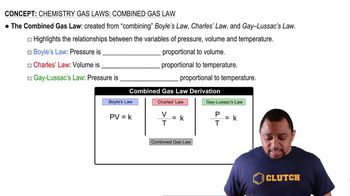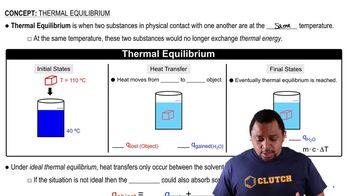Pakistan's K2 is the world's second-tallest mountain, with an altitude of 28,251 ft. Its base camp, where climbers stop to acclimate, is located about 16,400 ft above sea level. (a) Approximate atmospheric pressure P at different altitudes is given by the equation P = e-h/7000, where P is in atmospheres and h is the altitude in meters. What is the approximate atmospheric pressure in mm Hg at K2 base camp? (b) What is the atmospheric pressure in mm Hg at the summit of K2?

The apparatus shown consists of three temperature-jacketed 1.000-L bulbs connected by stopcocks. Bulb A contains a mixture of H2O(g), CO2(g), and N2(g) at 25 °C and a total pressure of 564 mm Hg. Bulb B is empty and is held at a temperature of -70 °C. Bulb C is also empty and is held at a temperature of -190 °C. The stopcocks are closed, and the volume of the lines connecting the bulbs is zero. CO2 sublimes at -78 °C, and N2 boils at -196 °C.
(a) The stopcock between A and B is opened, and the system is allowed to come to equilibrium. The pressure in A and B is now 219 mm Hg. What do bulbs A and B contain?
 Verified step by step guidance
Verified step by step guidance
Verified video answer for a similar problem:
Key Concepts
Phase Changes

Gas Laws

Equilibrium

Pakistan's K2 is the world's second-tallest mountain, with an altitude of 28,251 ft. Its base camp, where climbers stop to acclimate, is located about 16,400 ft above sea level. (c) Assuming the mole fraction of oxygen in air is 0.2095, what is the partial pressure of oxygen in mm Hg at the summit of K2?
The apparatus shown consists of three temperature-jacketed 1.000-L bulbs connected by stopcocks. Bulb A contains a mixture of H2O(g), CO2(g), and N2(g) at 25 °C and a total pressure of 564 mm Hg. Bulb B is empty and is held at a temperature of -70 °C. Bulb C is also empty and is held at a temperature of -190 °C. The stopcocks are closed, and the volume of the lines connecting the bulbs is zero. CO2 sublimes at -78 °C, and N2 boils at -196 °C.
(b) How many moles of H2O are in the system?
